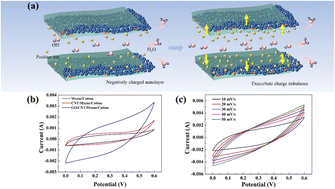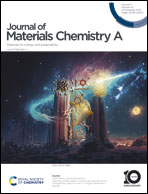Fabrication and study of a high output power flexible fabric hydrovoltaic generator†
Abstract
Energy production based on traditional fossil fuels is facing the problem of resource depletion, and energy harvesting from environmental moisture and natural water sources has attracted a great deal of attention from many experts and scholars, and has become a very promising technology. However, the currently existing hydrovoltaic generators are mainly based on the design principle of building structural gradients in materials and constructing electrokinetic potentials through nanoporous structures, which makes it difficult to realize high power generation. Here, inspired by the double-layer electric capacitor, we designed a flexible high-output power aqueous voltaic generator using pure cotton fabric as a carrier and MXene as a substrate, relying on the nucleophilic reaction to autonomously mount the intercalation materials CNT and GO on the cotton fiber. The prepared aqueous voltaic generator was able to simultaneously generate an open-circuit voltage (Voc) of up to ∼0.25 V and a short-circuit current (Isc) output of ∼520 μA in just 5 mL of simulated seawater (3.5 wt% NaCl) solution, and the optimized samples were able to achieve actual output current powers of 394.64 μA and 62.3 μW. It is superior to the vast majority of existing wet power generators. It is noteworthy that connecting a certain number of samples in series can drive the operation of a display and small LED bulbs of different colors. In contrast to previously reported hydrovoltaic generators, the energy power of this capacitor-excited hydrovoltaic generator is derived from the diffusion of ions and the adsorption of ions by the electrodes themselves. This generator also provides a way to generate power efficiently in a variety of water environments, which greatly broadens the working scenarios and improves the adaptability of the device in complex environments.



 Please wait while we load your content...
Please wait while we load your content...